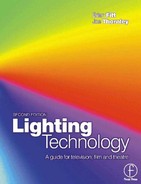0%
28Chapters
0-1Hours read
0kTotal Words
Book Description
Anyone working with lighting in the entertainment industries will find this an immensely readable source of information. The authors, themselves experienced lighting practitioners, have collected a wealth of essential lighting technology and data into one comprehensive reference volume in an accessible, jargon-free style.The new edition of this popular text covers the very latest technology, including advances in lamps, motorised lights, dimmers and control systems and current safety regulations.
Table of Contents
- Front Cover
- Half Title
- Title Page
- Copyright
- Contents
- Acknowledgements
- 1 Introduction
- 2 Lighting the subject
- 3 Theory of light
- 4 Light measurements
- 5 Light sources
- 6 Luminaires
- 7 Lighting suspension systems
- 8 Dimming and control
- 9 Studio technical design
- Introduction
- 9.1 Project team
- 9.2 Safety requirements
- 9.3 Greenfield sites and the refurbishment of existing premises
- 9.4 Building construction – how it can be influenced
- 9.5 Structural loads
- 9.6 Television studio requirements
- 9.7 The smaller studio
- 9.8 Air conditioning requirements
- 9.9 Power requirements
- 9.10 Acoustic requirements
- 10 Lighting for locations and sport
- 11 Motorised lights
- 12 Electrical distribution
- 13 Working lights and emergency systems
- 14 Safety
- 15 Maintaining and hiring lighting equipment
- Appendices
- I Glossary of terms
- II World mains voltages
- III Lamp tables
- IV Luminaire performances
- V Formulae and conversion tables
- Further reading
- Index
